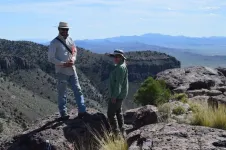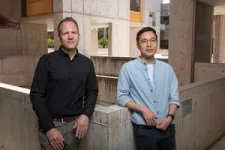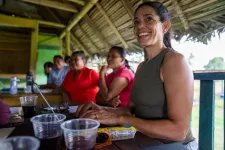(Press-News.org) RENO, Nev. – Powerful new digital mapping tools developed by University of Nevada, Reno researchers hold promise to improve management of rangeland, particularly public lands in the far-flung Western United States.
The significant improvements in mapping of vegetation enabled by the University’s research provide managers of rangeland, ranchers as well as federal managers of public lands, with better information to make large-scale decisions to mitigate effects of grazing, wildfire and other potential disruptions.
The research was conducted by Lucas Phipps, a rangeland ecologist, and Professor Tamzen Stringham, both in the Department of Agriculture, Veterinary & Rangeland Sciences in the University’s College of Agriculture, Biotechnology & Natural Resources. Stringham also conducts research as part of the College’s Experiment Station. The results were published this month in the journal Rangeland Ecology and Management.
Putting big data to work
Phipps explained that the new mapping process employs robust machine learning that crunches massive amounts of information gathered by satellite imagery as well as data gathered painstakingly by generations of scientists working on the ground. The result: Map grids that show vegetation patterns more accurately than previous methods.
Accurate information about vegetation is particularly important in Nevada, where the federal government owns more than 80% of the land. Many ranchers in the state want more flexibility in the management of the rangeland they lease from federal agencies. In fact, four ranches in the state have joined with the Bureau of Land Management to test management practices that provide ranchers with more ability to respond themselves to changing conditions.
But that sort of flexible management requires the best-possible information about vegetation and changes in vegetation patterns to ensure that rangeland is grazed appropriately, Phipps said.
Two of the Nevada ranches participating in the BLM’s Outcome-based Grazing Program — the Winecup-Gamble Ranch northeast of Wells and the Smith Creek Ranch west of Austin — became test sites for the mapping technology developed by University researchers.
The sprawling Winecup-Gamble Ranch would be particularly challenging for traditional vegetation-mapping techniques, Phipps said. The ranch encompasses about a million acres, an area larger than Rhode Island, along the Nevada-Utah state line. Many of the remote stretches of the ranch would be difficult for on-the-ground monitoring of vegetation.
High-quality mapping
In the past, vegetation maps were created from studies of soil types, along with data about factors such as rainfall, average temperatures and elevation. The advent of remote data from NASA’s Landsat satellite allowed researchers to create large-scale maps beginning in the mid-1980s, and researchers began to use satellite imagery to track large-scale changes from one year to the next.
The process developed by Phipps and Stringham uses machine-learning analysis of more than 40 environmental variables, to develop vegetation maps that have more information, and better-quality information, than existing mapping products. Maps generated by the new process were validated by on-the-ground observations at 450 sites.
Despite the accuracy and wide vision of the vegetation maps generated by machine learning and remote imaging, Phipps said the new technology still can’t replace the observations of skilled scientists working in the field.
“Boots-on-the-ground remains the gold standard,” he said. “But to create maps of large areas, or remote areas, it becomes a manpower problem.”
Impacting the West, the world
The mapping project, Phipps said, fits well with the University’s mission as a land-grant university, where much of the work focuses on improving the daily lives of people across Nevada and beyond. Efforts to help wildlands recover from the disruptions of fire, mining exploration and off-highway vehicles all will be strengthened by better understanding of vegetation patterns.
While the new vegetation mapping was developed on the two Nevada ranches, Phipps said a clear next step would involve its rollout across the remainder of Nevada and neighboring states.
And it’s not just Nevada and other Western states that will stand to benefit. Phipps said other countries that haven’t undertaken extensive soil surveys could use the new technology to develop high-quality vegetation maps that will allow them to make better decisions.
“The scientific community, ranchers and federal land managers all share an interest in good stewardship of rangelands,” Phipps said. “They’ve been really complimentary of the University’s work, as they have seen the possibilities of this important new tool for vegetation mapping.”
- @unevadareno –
The University of Nevada, Reno, is a public research university that is committed to the promise of a future powered by knowledge. As a Nevada land-grant university founded in 1874, the University serves 21,000 students. The University is a comprehensive, doctoral university, classified as an R1 institution with very high research activity by the Carnegie Classification of Institutions of Higher Education. Additionally, it has attained the prestigious “Carnegie Engaged” classification, reflecting its student and institutional impact on civic engagement and service, fostered by extensive community and statewide collaborations. More than $800 million in advanced labs, residence halls and facilities has been invested on campus since 2009. It is home to the University of Nevada, Reno School of Medicine and Wolf Pack Athletics, maintains a statewide outreach mission and presence through programs such as the University of Nevada, Reno Extension, Nevada Bureau of Mines and Geology, Small Business Development Center, Nevada Seismological Laboratory, and is part of the Nevada System of Higher Education. Through a commitment to world-improving research, student success and outreach benefiting the communities and businesses of Nevada, the University has impact across the state and around the world. For more information, visit www.unr.edu.
END
by Brooke McDonald
It turns out a common cockroach found across the globe is a pest of our own making.
In a study recently published in Proceedings of the National Academy of Sciences, Texas A&M AgriLife researchers unveiled insights into the origins of the common German cockroach, Blattella germanica.
The study, “Solving the 250-year-old ...
LOS ANGELES – June 3, 2024 – For the last three decades, breakthroughs have been sparse for soft tissue sarcomas, which are rare cancers that affect muscles, fat and other connective tissues. Today, a global team of researchers funded by a Stand Up To Cancer® (SU2C) grant announced clinical trial results that point to a new immunotherapy treatment option for two of the most common types of soft tissue sarcoma in adults, a breakthrough that reduces the risk of relapse by 43% at two years and will ...
Berlin, Germany: Disturbed sleep is very common in almost all neuropsychiatric and neurodevelopmental conditions (NDPCs), such as autism, attention deficit and hyperactivity disorder, schizophrenia, and bipolar disorder. While it is understandable that the symptoms of such conditions would lead to sleep disruption and also that sleep disruption would worsen symptoms in these conditions, Irish researchers have now found new genetic associations between some of these conditions and chronotype, the behavioural manifestations of an individual’s ...
Slowing down the pace may not be common in academia, but it could lead to better science to support our planet through the current climate, biodiversity and social justice crises. This is one approach suggested by a diverse group of marine conservation scientists who were brought together in 2021 by the COMPASS “Leaders for Sea Change” Science Communication program. In a new paper published in Proceedings of the National Academy of Sciences (PNAS), the co-authors consider three pathways to better connect with the places they study.
Frequently, scientific expertise to address the global change crisis comes ...
A simple survey delivered during the first trimester through digital pregnancy support app MyHealthyPregnancy predicted which mothers went on to develop moderate to severe depression with a high level of accuracy, according to a new Archives of Women’s Mental Health study led by University of Pittsburgh and UPMC researchers.
“Depression is a leading complication during pregnancy with about 15% of patients reporting symptoms at some point in their pregnancy journey,” said lead author Tamar Krishnamurti, Ph.D., associate professor of general internal medicine ...
Supplemental oxygen is among the most widely prescribed therapies in the world, with an estimated 13 to 20 million patients worldwide requiring oxygen delivery by mechanical ventilation each year. Mechanical ventilation — a form of life support — is a technology that moves breathable air into and out of the lungs, acting like a bellows. Ventilators have moved far beyond the “iron lung” machines some people might picture; now, apparatuses have progressed to sophisticated, compact digital machines that deliver oxygen through a small plastic tube that goes down the throat.
Despite technological advancements, ...
NEW ORLEANS (June 3, 2024) – Dr. Demetrius James Porche, Dean of LSU Health New Orleans School of Nursing, has been appointed as a member of the seventh cohort of Ambassadors by the Friends of the National Institute of Nursing Research (FNINR). This prestigious selection recognizes his exceptional contributions to nursing research and advocacy.
The FNINR Ambassador program, initiated in 2014, comprises highly qualified individuals committed to advancing public, health professional and policymaker awareness of the significant research agenda of the National Institute for Nursing Research ...
MIAMI, FLORIDA (June 3, 2024) – Estelamari Rodriguez, M.D., M.P.H., is the recipient of the Patient Educator of the Year award from Cancer GRACE (Global Resource for Advancing Cancer Education). The award was presented May 31 in Chicago in recognition of Rodriguez’s work in breaking down language barriers around the world by creating Spanish-language educational content about lung cancer for patients and caregivers.
As a physician and a Latina, Rodriguez, a bilingual thoracic oncologist at Sylvester Comprehensive Cancer Center, part of the University of Miami Health System, ...
Even as classrooms, offices, concerts and weddings have begun to look more like their pre-2020 counterparts, marks of the global pandemic remain visible in new norms and long-term issues.
“COVID-19 affected a whole generation of individuals at every level,” said Khalid Afzal, MD, a pediatric psychiatrist at the University of Chicago Medicine.
In conversations on social media and in other forums, many people share a general sense that COVID-19 had a significant impact on mental health — that it represents a collective trauma from which we will be healing for years. Now that researchers have a few years’ worth of data to analyze, they’re beginning to unpack that ...
FOR IMMEDIATE RELEASE
Monday, June 3, 2024
Contact:
Jillian McKoy, jpmckoy@bu.edu
Michael Saunders, msaunder@bu.edu
##
Researchers: Excluding Partisanship Questions from Public Health Surveys ‘Limits Our Capacity for Advancing Population Health and Health Equity’
A new commentary in the American Journal of Public Health urges public health researchers to incorporate questions about partisan identity in demographic data collection, arguing that excluding this information could lead to ineffective policy and health promotion interventions.
The partisan divide in attitudes toward vaccination and masking during the COVID-19 pandemic made clear that ...





